The Cambridge History of Japan, Vol. 1: Ancient Japan
Подождите немного. Документ загружается.

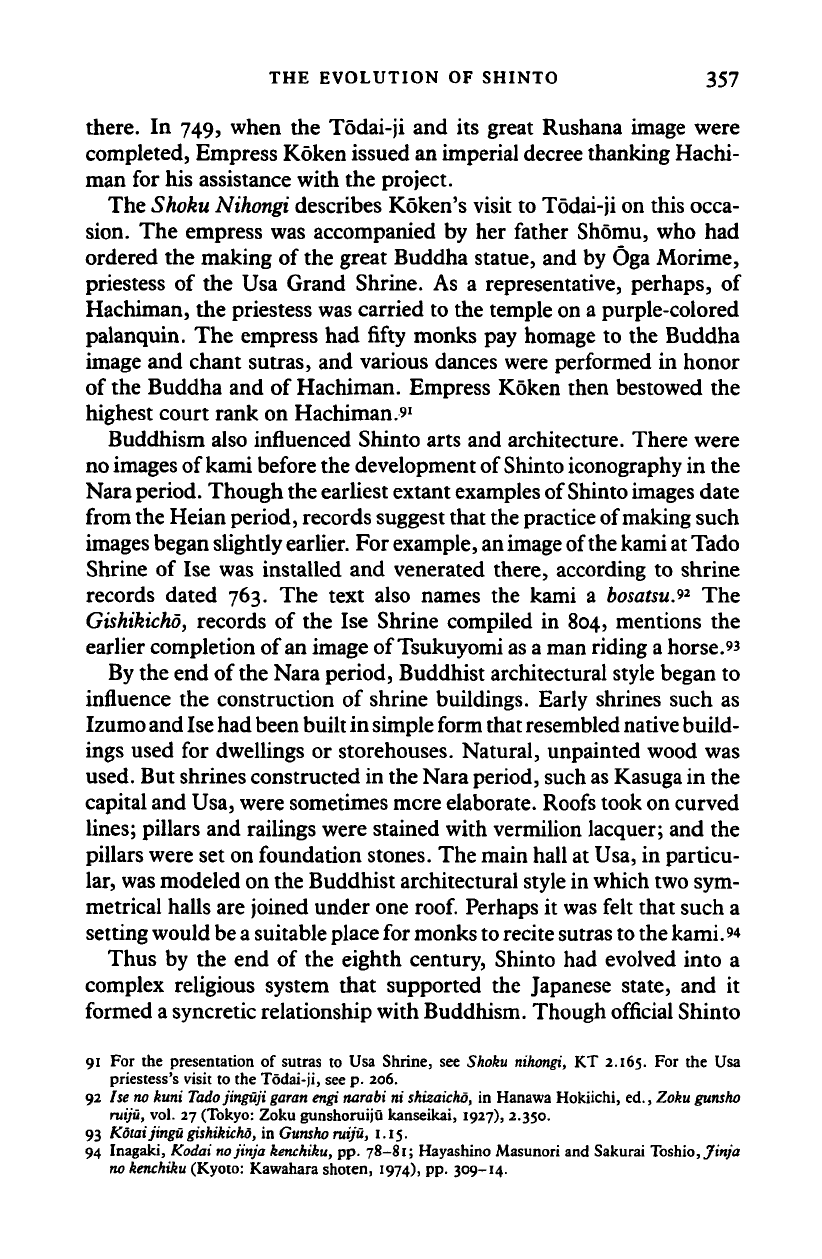
THE EVOLUTION OF SHINTO 357
there. In 749, when the T6dai-ji and its great Rushana image were
completed, Empress Koken issued an imperial decree thanking Hachi-
man for his assistance with the project.
The Shoku
Nihongi
describes Koken's visit to T6dai-ji on this occa-
sion. The empress was accompanied by her father Shomu, who had
ordered the making of the great Buddha statue, and by Oga Morime,
priestess of the Usa Grand Shrine. As a representative, perhaps, of
Hachiman, the priestess was carried to the temple on a purple-colored
palanquin. The empress had fifty monks pay homage to the Buddha
image and chant sutras, and various dances were performed in honor
of the Buddha and of Hachiman. Empress Koken then bestowed the
highest court rank on Hachiman.'
1
Buddhism also influenced Shinto arts and architecture. There were
no images of kami before the development of Shinto iconography in the
Nara period. Though the earliest extant examples of Shinto images date
from the Heian period, records suggest that the practice of making such
images began slightly
earlier.
For
example,
an image
of
the kami at
Tado
Shrine of Ise was installed and venerated there, according to shrine
records dated 763. The text also names the kami a
bosatsu.*
1
The
Gishikicho,
records of the Ise Shrine compiled in 804, mentions the
earlier completion of an image of Tsukuyomi as a man riding
a
horse.'*
By the end of the Nara period, Buddhist architectural style began to
influence the construction of shrine buildings. Early shrines such as
Izumo and Ise had been built in simple form that resembled
native
build-
ings used for dwellings or storehouses. Natural, unpainted wood was
used. But shrines constructed in the Nara period, such
as
Kasuga in the
capital and Usa, were sometimes mere elaborate. Roofs took on curved
lines;
pillars and railings were stained with vermilion lacquer; and the
pillars were set on foundation stones. The main hall at Usa, in particu-
lar, was modeled on the Buddhist architectural style in which two sym-
metrical halls are joined under one
roof.
Perhaps it was felt that such a
setting would
be a
suitable
place
for monks
to
recite sutras
to
the kami.**
Thus by the end of the eighth century, Shinto had evolved into a
complex religious system that supported the Japanese state, and it
formed a syncretic relationship with Buddhism. Though official Shinto
91 For the presentation of sutras to Usa Shrine, see Shoku nihongi, KT 2.165. F°
r
the Usa
priestess's visit to the Todai-ji, see p. 206.
92 Ise no kuni Tadojinguji garan engi narabi ni shizaicho, in Hanawa Hokiichi, ed., Zoku gunsho
ruiju, vol. 27 (Tokyo: Zoku gunshoruiju kanseikai, 1927), 2.350.
93 Kotaijingu
gishikicho,
in
Gunsho
ruiju, 1.15.
94 Inagaki, Kodai nojinja
kenchiku,
pp.
78-81;
Hayashino Masunori and Sakurai Toshio, Jinja
no
kenchiku
(Kyoto: Kawahara shoten, 1974), pp. 309-14.
Cambridge Histories Online © Cambridge University Press, 2008
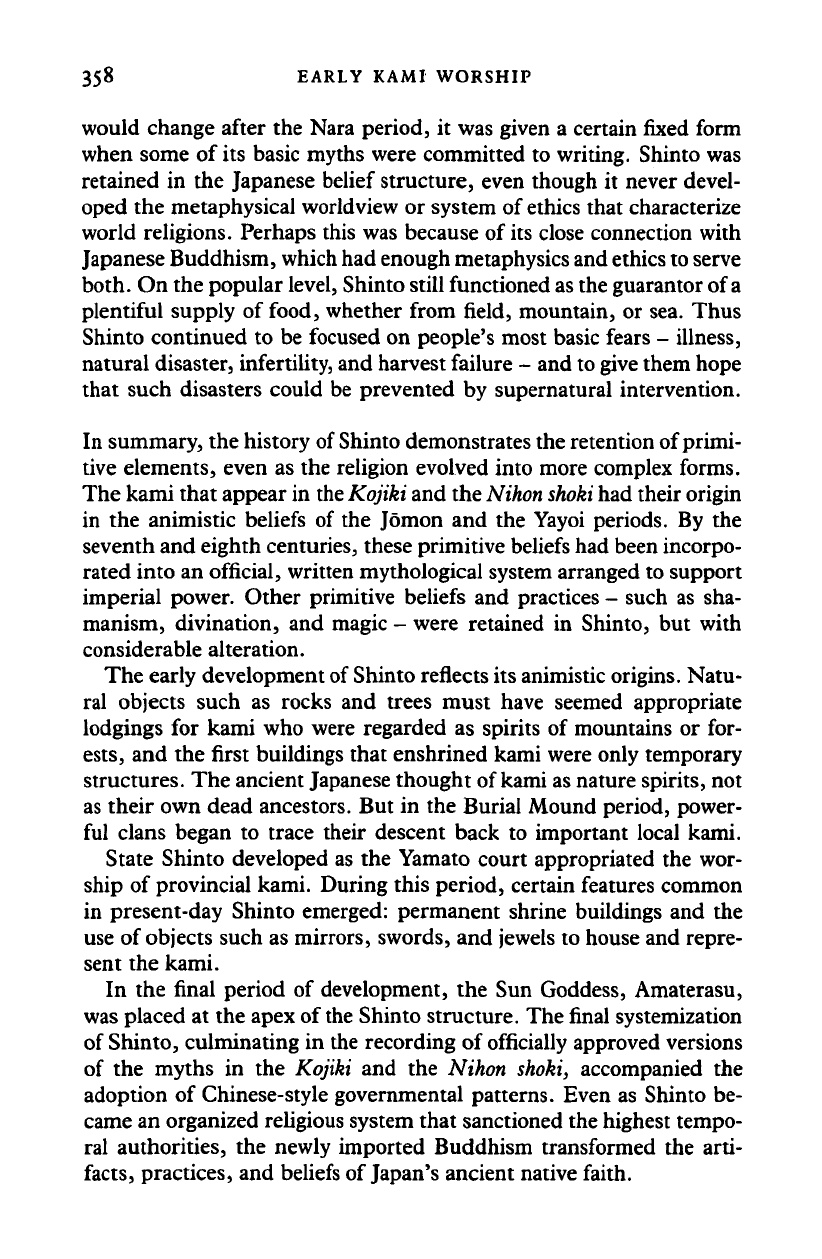
358 EARLY KAMI WORSHIP
would change after the Nara period, it was given a certain fixed form
when some of its basic myths were committed to writing. Shinto was
retained in the Japanese belief structure, even though it never devel-
oped the metaphysical worldview or system of
ethics
that characterize
world religions. Perhaps this was because of its close connection with
Japanese Buddhism, which had enough metaphysics and ethics to serve
both. On the popular level, Shinto still functioned as the guarantor of a
plentiful supply of food, whether from field, mountain, or sea. Thus
Shinto continued to be focused on people's most basic fears - illness,
natural disaster, infertility, and harvest failure - and to give them hope
that such disasters could be prevented by supernatural intervention.
In summary, the history of Shinto demonstrates the retention of primi-
tive elements, even as the religion evolved into more complex forms.
The kami that appear in
the
Kojiki and the
Nihon shoki
had their origin
in the animistic beliefs of the Jomon and the Yayoi periods. By the
seventh and eighth centuries, these primitive beliefs had been incorpo-
rated into an official, written mythological system arranged to support
imperial power. Other primitive beliefs and practices - such as sha-
manism, divination, and magic - were retained in Shinto, but with
considerable alteration.
The early development of Shinto reflects its animistic origins. Natu-
ral objects such as rocks and trees must have seemed appropriate
lodgings for kami who were regarded as spirits of mountains or for-
ests,
and the first buildings that enshrined kami were only temporary
structures. The ancient Japanese thought of
kami
as nature spirits, not
as their own dead ancestors. But in the Burial Mound period, power-
ful clans began to trace their descent back to important local kami.
State Shinto developed as the Yamato court appropriated the wor-
ship of provincial kami. During this period, certain features common
in present-day Shinto emerged: permanent shrine buildings and the
use of objects such as mirrors, swords, and jewels to house and repre-
sent the kami.
In the final period of development, the Sun Goddess, Amaterasu,
was placed at the apex of
the
Shinto structure. The final systemization
of Shinto, culminating in the recording of officially approved versions
of the myths in the Kojiki and the Nihon shoki, accompanied the
adoption of Chinese-style governmental patterns. Even as Shinto be-
came an organized religious system that sanctioned the highest tempo-
ral authorities, the newly imported Buddhism transformed the arti-
facts,
practices, and beliefs of Japan's ancient native faith.
Cambridge Histories Online © Cambridge University Press, 2008
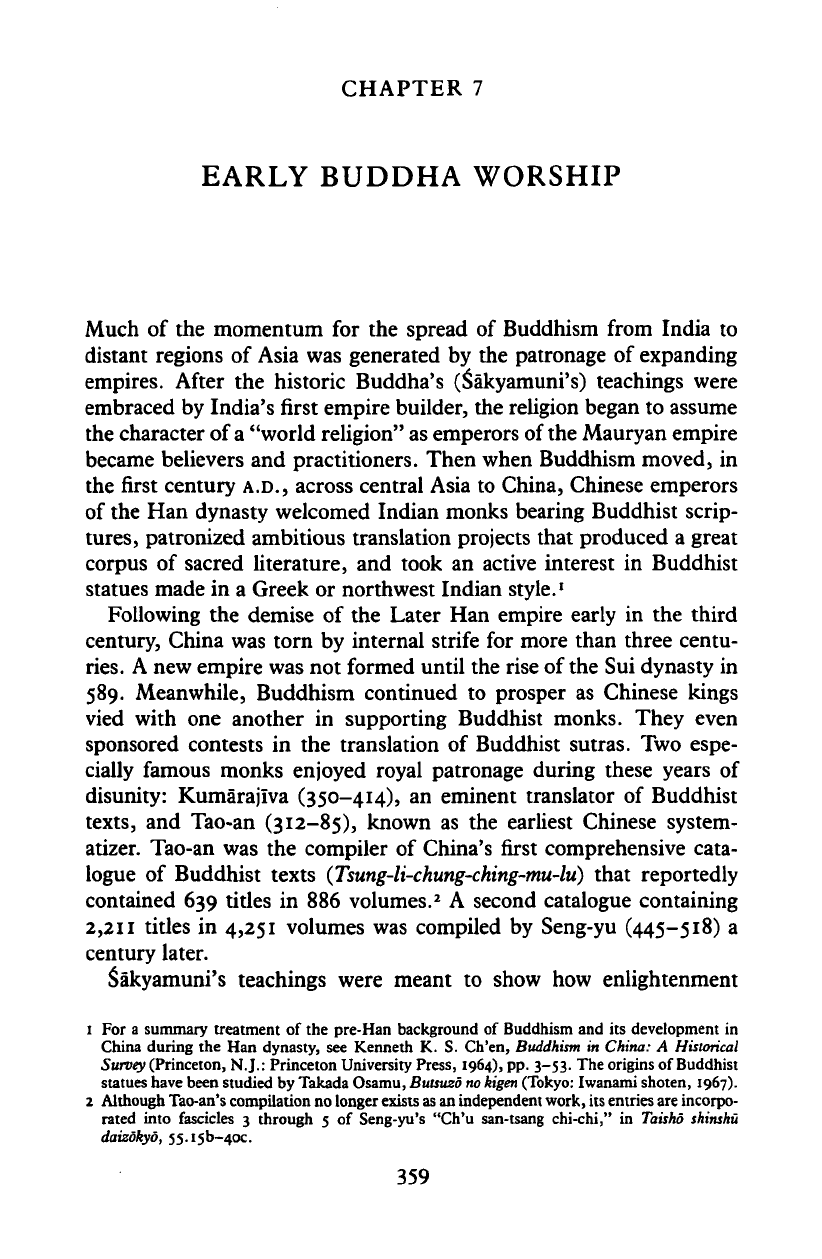
CHAPTER 7
EARLY BUDDHA WORSHIP
Much of the momentum for the spread of Buddhism from India to
distant regions of Asia was generated by the patronage of expanding
empires. After the historic Buddha's (Sakyamuni's) teachings were
embraced by India's first empire builder, the religion began to assume
the character of
a
"world religion" as emperors of
the
Mauryan empire
became believers and practitioners. Then when Buddhism moved, in
the first century
A.D.,
across central Asia to China, Chinese emperors
of the Han dynasty welcomed Indian monks bearing Buddhist scrip-
tures,
patronized ambitious translation projects that produced a great
corpus of sacred literature, and took an active interest in Buddhist
statues made in a Greek or northwest Indian style.
1
Following the demise of the Later Han empire early in the third
century, China was torn by internal strife for more than three centu-
ries.
A new empire was not formed until the rise of the Sui dynasty in
589.
Meanwhile, Buddhism continued to prosper as Chinese kings
vied with one another in supporting Buddhist monks. They even
sponsored contests in the translation of Buddhist sutras. Two espe-
cially famous monks enjoyed royal patronage during these years of
disunity: Kumarajiva (350-414), an eminent translator of Buddhist
texts,
and Tao-an (312-85), known as the earliest Chinese system-
atizer. Tao-an was the compiler of China's first comprehensive cata-
logue of Buddhist texts
(Tsung-U-chung-ching-mu-lu)
that reportedly
contained 639 titles in 886 volumes.
2
A second catalogue containing
2,211 titles in 4,251 volumes was compiled by Seng-yu (445-518) a
century later.
Sakyamuni's teachings were meant to show how enlightenment
1 For a summary treatment of the pre-Han background of Buddhism and its development in
China during the Han dynasty, see Kenneth K. S. Ch'en,
Buddhism
in
China:
A
Historical
Survey
(Princeton, N.J.: Princeton University Press,
1964),
pp. 3-53. The origins of Buddhist
statues have been studied by Takada Osamu,
Butsuzo no kigen
(Tokyo:
Iwanami shoten, 1967).
2 Although Tao-an's compilation no longer
exists as
an independent work, its entries are incorpo-
rated into fascicles 3 through 5 of Seng-yu's "Ch'u san-tsang chi-chi," in
Taisho shinshu
daizokyo,
55.i5b-4oc.
359
Cambridge Histories Online © Cambridge University Press, 2008
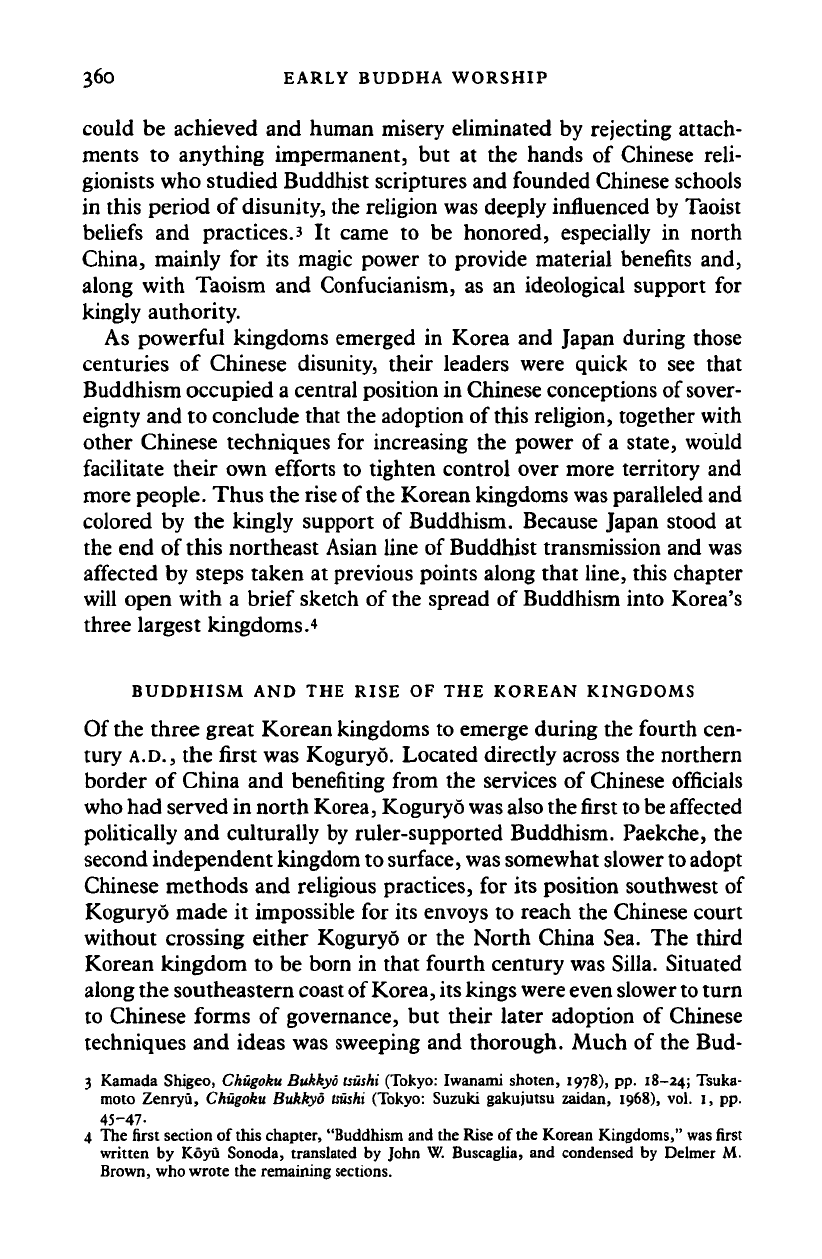
360 EARLY BUDDHA WORSHIP
could be achieved and human misery eliminated by rejecting attach-
ments to anything impermanent, but at the hands of Chinese reli-
gionists who studied Buddhist scriptures and founded Chinese schools
in this period of disunity, the religion was deeply influenced by Taoist
beliefs and practices.3 It came to be honored, especially in north
China, mainly for its magic power to provide material benefits and,
along with Taoism and Confucianism, as an ideological support for
kingly authority.
As powerful kingdoms emerged in Korea and Japan during those
centuries of Chinese disunity, their leaders were quick to see that
Buddhism occupied a central position in Chinese conceptions of sover-
eignty and to conclude that the adoption of this religion, together with
other Chinese techniques for increasing the power of a state, would
facilitate their own efforts to tighten control over more territory and
more people. Thus the rise of
the
Korean kingdoms was paralleled and
colored by the kingly support of Buddhism. Because Japan stood at
the end of this northeast Asian line of Buddhist transmission and was
affected by steps taken at previous points along that line, this chapter
will open with a brief sketch of the spread of Buddhism into Korea's
three largest kingdoms.
4
BUDDHISM AND THE RISE OF THE KOREAN KINGDOMS
Of the three great Korean kingdoms to emerge during the fourth cen-
tury
A.D.,
the first was Koguryo. Located directly across the northern
border of China and benefiting from the services of Chinese officials
who had served in north Korea, Koguryo
was also
the
first
to
be
affected
politically and culturally by ruler-supported Buddhism. Paekche, the
second independent kingdom to surface, was somewhat slower
to
adopt
Chinese methods and religious practices, for its position southwest of
Koguryo made it impossible for its envoys to reach the Chinese court
without crossing either Koguryo or the North China Sea. The third
Korean kingdom to be born in that fourth century was Silla. Situated
along the southeastern coast of Korea,
its
kings
were
even slower
to
turn
to Chinese forms of governance, but their later adoption of Chinese
techniques and ideas was sweeping and thorough. Much of the Bud-
3 Kamada Shigeo,
Chugoku
Bukkyo
tsushi
(Tokyo: Iwanami shot en, 1978), pp. 18-24; Tsuka-
moto Zenryu,
Chugoku
Bukkyo
isiishi
(Tokyo: Suzuki gakujutsu zaidan, 1968), vol. 1, pp.
45-47-
4 The first section of this chapter, "Buddhism and the Rise of the Korean Kingdoms," was first
written by Koyu Sonoda, translated by John W. Buscaglia, and condensed by Delmer M.
Brown, who wrote the remaining sections.
Cambridge Histories Online © Cambridge University Press, 2008
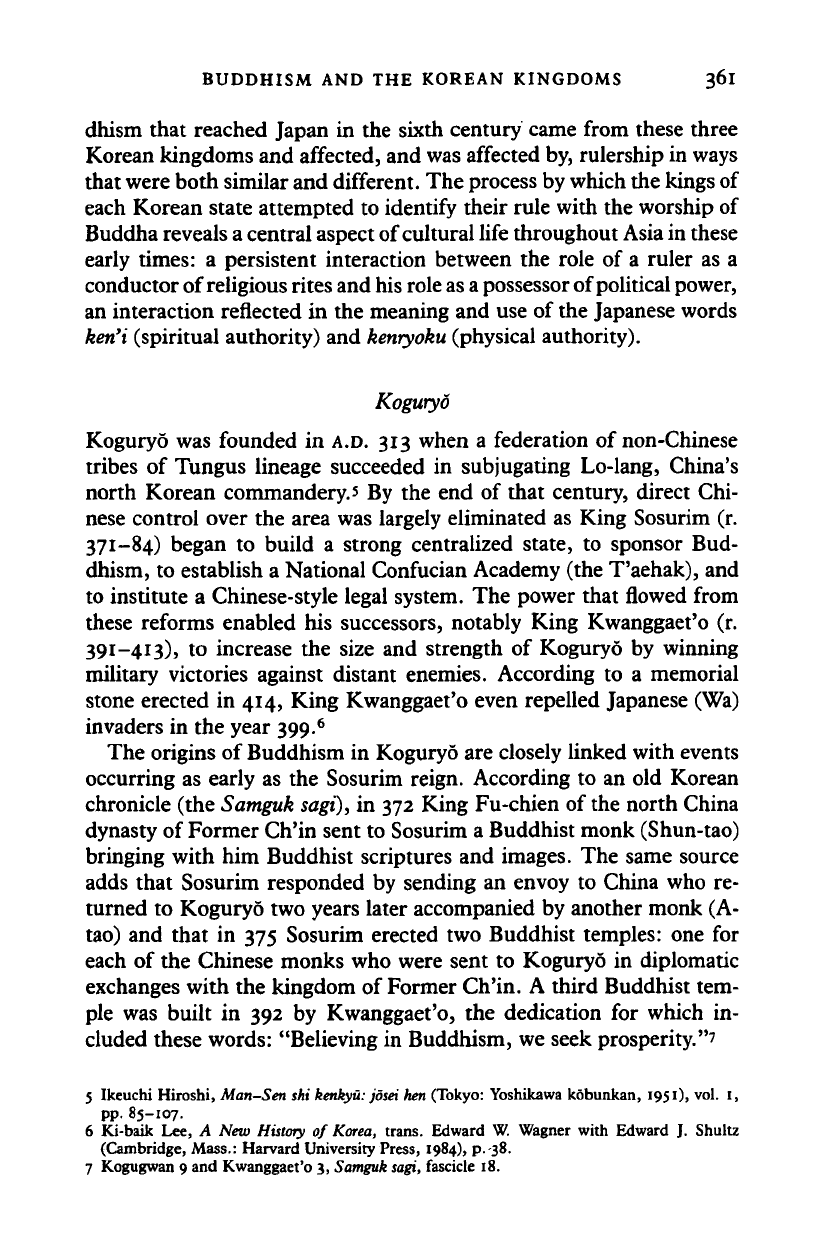
BUDDHISM AND THE KOREAN KINGDOMS 361
dhism that reached Japan in the sixth century came from these three
Korean kingdoms and affected, and was affected by, rulership in ways
that were both similar and different. The process by which the kings
of
each Korean state attempted to identify their rule with the worship of
Buddha reveals a central aspect of cultural life throughout Asia in these
early times: a persistent interaction between the role of a ruler as a
conductor of religious rites and his
role as a
possessor of political power,
an interaction reflected in the meaning and use of the Japanese words
ken'i (spiritual authority) and
kenryoku
(physical authority).
Koguryo
Koguryo was founded in
A.D.
313 when a federation of non-Chinese
tribes of Tungus lineage succeeded in subjugating Lo-lang, China's
north Korean commandery.5 By the end of that century, direct Chi-
nese control over the area was largely eliminated as King Sosurim (r.
371-84) began to build a strong centralized state, to sponsor Bud-
dhism, to establish a National Confucian Academy (the T'aehak), and
to institute a Chinese-style legal system. The power that flowed from
these reforms enabled his successors, notably King Kwanggaet'o (r.
391-413), to increase the size and strength of Koguryo by winning
military victories against distant enemies. According to a memorial
stone erected in 414, King Kwanggaet'o even repelled Japanese (Wa)
invaders in the year 399.
6
The origins of Buddhism in Koguryo are closely linked with events
occurring as early as the Sosurim reign. According to an old Korean
chronicle (the Samguk
sagi),
in 372 King Fu-chien of the north China
dynasty of Former Ch'in sent to Sosurim a Buddhist monk (Shun-tao)
bringing with him Buddhist scriptures and images. The same source
adds that Sosurim responded by sending an envoy to China who re-
turned to Koguryo two years later accompanied by another monk (A-
tao) and that in 375 Sosurim erected two Buddhist temples: one for
each of the Chinese monks who were sent to Koguryo in diplomatic
exchanges with the kingdom of Former Ch'in. A third Buddhist tem-
ple was built in 392 by Kwanggaet'o, the dedication for which in-
cluded these words: "Believing in Buddhism, we seek prosperity."7
5 Ikeuchi Hiroshi, Man-Sen shi kenkyu: josei hen (Tokyo: Yoshikawa kobunkan, 1951), vol. 1,
pp.
85-107.
6 Ki-baik Lee, A New History of Korea, trans. Edward W. Wagner with Edward J. Shultz
(Cambridge, Mass.: Harvard University Press, 1984),
p.-38.
7 Kogugwan 9 and Kwanggaet'o 3, Samguk sagi, fascicle 18.
Cambridge Histories Online © Cambridge University Press, 2008
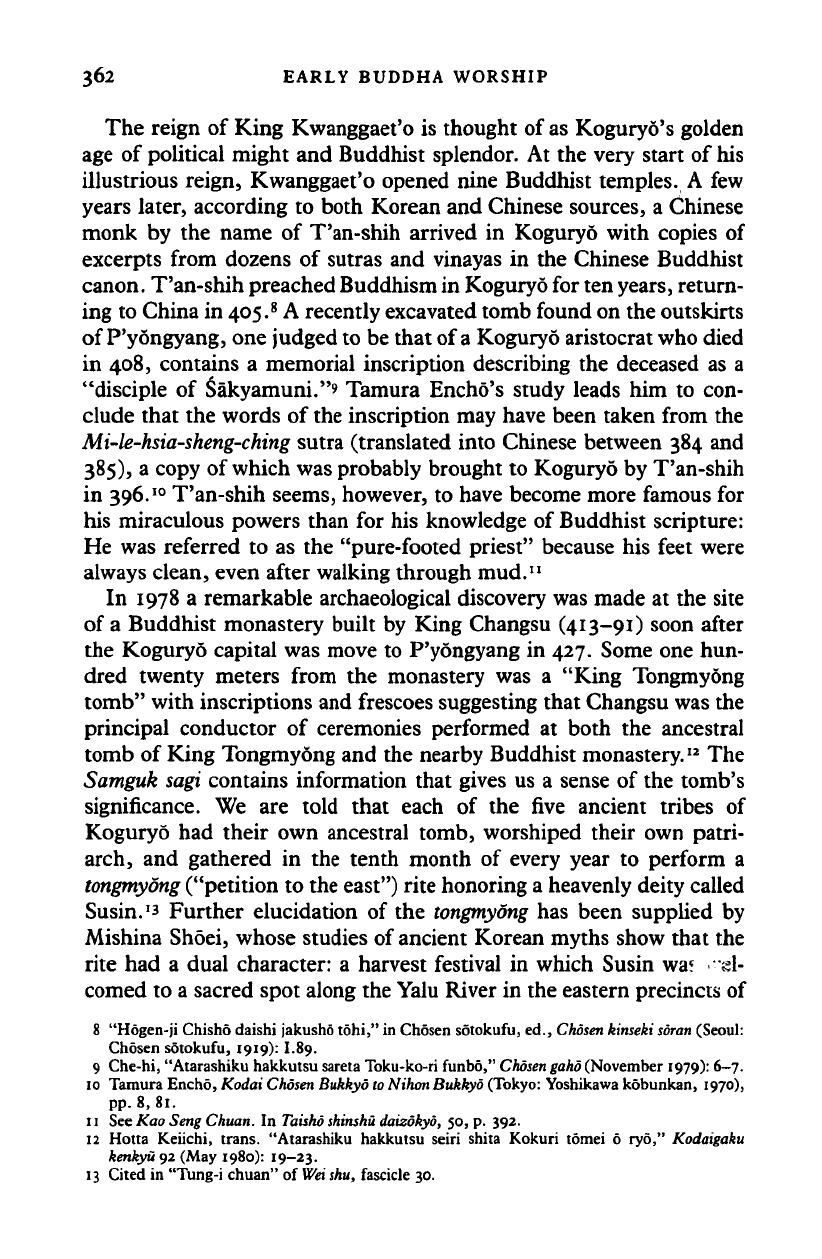
362 EARLY BUDDHA WORSHIP
The reign of King Kwanggaet'o is thought of as Koguryo's golden
age of political might and Buddhist splendor. At the very start of his
illustrious reign, Kwanggaet'o opened nine Buddhist temples. A few
years later, according to both Korean and Chinese sources, a Chinese
monk by the name of T'an-shih arrived in Koguryo with copies of
excerpts from dozens of sutras and vinayas in the Chinese Buddhist
canon. T'an-shih preached Buddhism in Koguryo for ten
years,
return-
ing to China in
405.
8
A recently excavated tomb found on the outskirts
of P'yongyang, one judged to be that of a Koguryo aristocrat who died
in 408, contains a memorial inscription describing the deceased as a
"disciple of Sakyamuni."
9
Tamura Encho's study leads him to con-
clude that the words of the inscription may have been taken from the
Mi-le-hsia-sheng-ching
sutra (translated into Chinese between 384 and
385),
a copy of which was probably brought to Koguryo by T'an-shih
in 396.
10
T'an-shih seems, however, to have become more famous for
his miraculous powers than for his knowledge of Buddhist scripture:
He was referred to as the "pure-footed priest" because his feet were
always clean, even after walking through mud."
In 1978 a remarkable archaeological discovery was made at the site
of a Buddhist monastery built by King Changsu (413-91) soon after
the Koguryo capital was move to P'yongyang in 427. Some one hun-
dred twenty meters from the monastery was a "King Tongmyong
tomb"
with inscriptions and frescoes suggesting that Changsu was the
principal conductor of ceremonies performed at both the ancestral
tomb of King Tongmyong and the nearby Buddhist monastery.
12
The
Samguk
sagi
contains information that gives us a sense of the tomb's
significance. We are told that each of the five ancient tribes of
Koguryo had their own ancestral tomb, worshiped their own patri-
arch, and gathered in the tenth month of every year to perform a
tongmyong
("petition to the east") rite honoring a heavenly deity called
Susin.
13
Further elucidation of the
tongmydng
has been supplied by
Mishina Shoei, whose studies of ancient Korean myths show that the
rite had a dual character: a harvest festival in which Susin waf "gl-
comed to a sacred spot along the Yalu River in the eastern precincts of
8 "Hogen-ji Chisho daishi jakusho tohi," in Chosen sotokufu, ed.,
Chosen
kinseki
soran
(Seoul:
Chosen sotokufu, 1919): 1.89.
9 Che-hi, "Atarashiku hakkutsu sareta Toku-ko-ri funbo,"
Chosen gaho
(November 1979): 6-7.
10 Tamura Encho, Kodai
Chosen
Bukkyo
to
Nihon Bukkyo (Tokyo: Yoshikawa kobunkan, 1970),
pp.
8, 81.
11 See Kao Seng Chuan. In
Taisho
shins
hu
daizokyo, 50, p. 392.
12 Hotta Keiichi, trans. "Atarashiku hakkutsu seiri shita Kokuri tomei 6 176," Kodaigaku
kenkyu 92 (May 1980): 19-23.
13 Cited in "Tung-i chuan" of
Wei
shu,
fascicle 30.
Cambridge Histories Online © Cambridge University Press, 2008
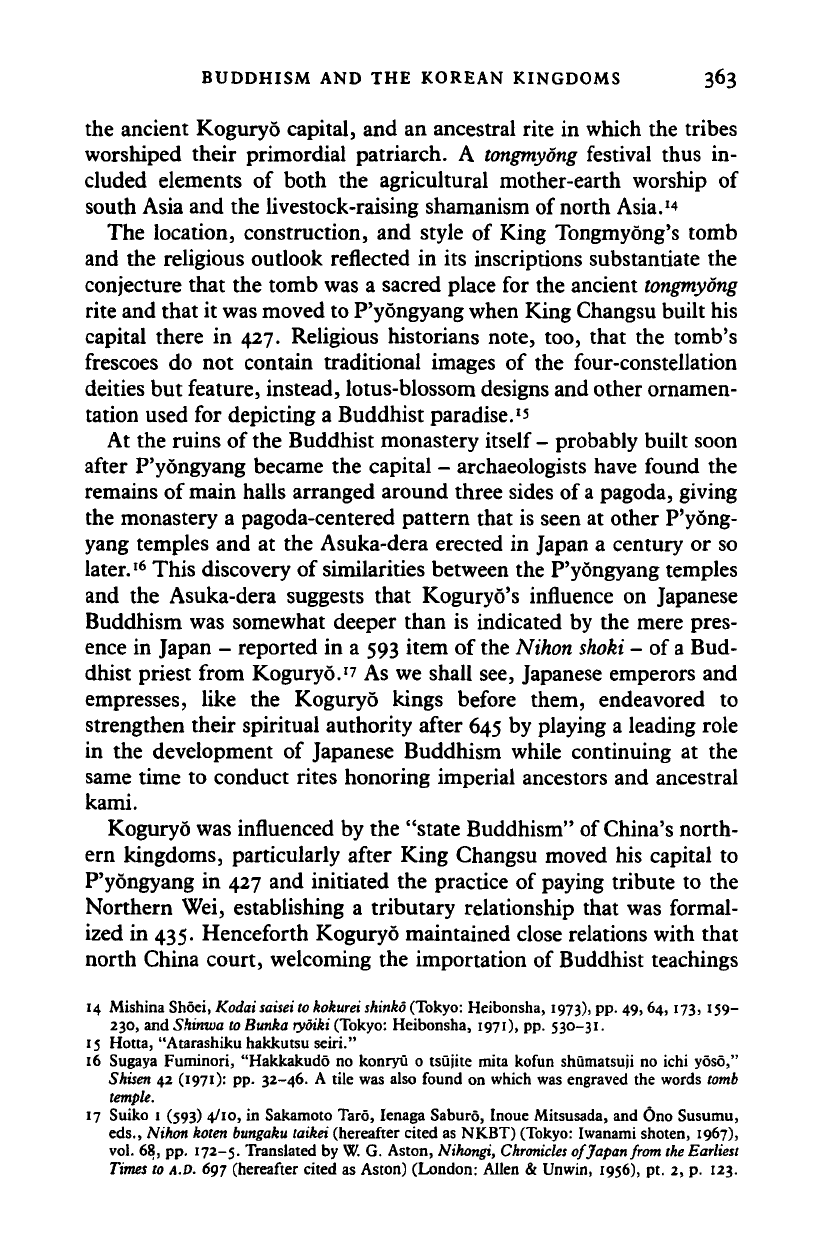
BUDDHISM AND THE KOREAN KINGDOMS 363
the ancient Koguryo capital, and an ancestral rite in which the tribes
worshiped their primordial patriarch. A
tongmyong
festival thus in-
cluded elements of both the agricultural mother-earth worship of
south Asia and the livestock-raising shamanism of north Asia.
1
''
The location, construction, and style of King Tongmyong's tomb
and the religious outlook reflected in its inscriptions substantiate the
conjecture that the tomb was a sacred place for the ancient
tongmyong
rite and that it was moved to P'yongyang when King Changsu built his
capital there in 427. Religious historians note, too, that the tomb's
frescoes do not contain traditional images of the four-constellation
deities but feature, instead, lotus-blossom designs and other ornamen-
tation used for depicting a Buddhist paradise.'5
At the ruins of the Buddhist monastery itself - probably built soon
after P'yongyang became the capital - archaeologists have found the
remains of main halls arranged around three sides of
a
pagoda, giving
the monastery a pagoda-centered pattern that is seen at other P'yong-
yang temples and at the Asuka-dera erected in Japan a century or so
later.
16
This discovery of similarities between the P'yongyang temples
and the Asuka-dera suggests that Koguryo's influence on Japanese
Buddhism was somewhat deeper than is indicated by the mere pres-
ence in Japan - reported in a 593 item of the Nihon
shoki
- of
a
Bud-
dhist priest from Koguryo.'7 As we shall see, Japanese emperors and
empresses, like the Koguryo kings before them, endeavored to
strengthen their spiritual authority after 645 by playing a leading role
in the development of Japanese Buddhism while continuing at the
same time to conduct rites honoring imperial ancestors and ancestral
kami.
Koguryo was influenced by the "state Buddhism" of China's north-
ern kingdoms, particularly after King Changsu moved his capital to
P'yongyang in 427 and initiated the practice of paying tribute to the
Northern Wei, establishing a tributary relationship that was formal-
ized in 435. Henceforth Koguryo maintained close relations with that
north China court, welcoming the importation of Buddhist teachings
14 Mishina Shoe:, Kodai
saisei
to
kokurei shinko
(Tokyo: Heibonsha, 1973), pp. 49,64,173, 159-
230,
and Shinwa
to
Bunka ryoiki (Tokyo: Heibonsha, 1971), pp. 530-31.
15 Hotta, "Atarashiku hakkutsu seiri."
16 Sugaya Fuminori, "Hakkakudo no konryu o tsujite mita kofun shumatsuji no ichi yoso,"
Shisen 42 (1971): pp. 32-46. A tile was also found on which was engraved the words tomb
temple.
17 Suiko 1 (593) 4/10, in Sakamoto Taro, Ienaga Saburo, Inoue Mitsusada, and Ono Susumu,
eds.,
Nihon koten
bungaku
taikei (hereafter cited as NKBT) (Tokyo: Iwanami shoten, 1967),
vol. 68, pp. 172-5. Translated by W. G. Aston, Nihongi,
Chronicles
of Japan
from the
Earliest
Times to
A.D.
697 (hereafter cited as Aston) (London: Allen & Unwin, 1956), pt. 2, p. 123.
Cambridge Histories Online © Cambridge University Press, 2008
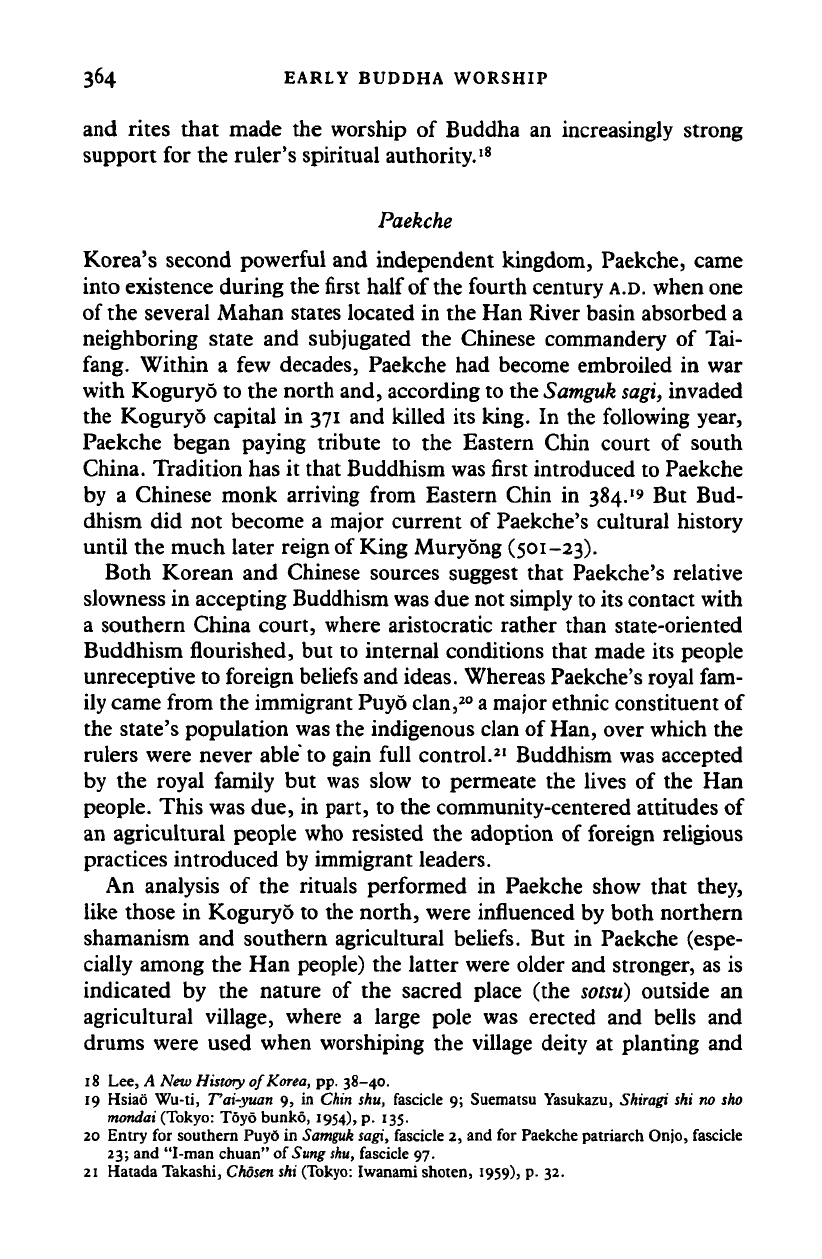
364 EARLY BUDDHA WORSHIP
and rites that made the worship of Buddha an increasingly strong
support for the ruler's spiritual authority.
18
Paekche
Korea's second powerful and independent kingdom, Paekche, came
into existence during the first half of the fourth century
A.D.
when one
of the several Mahan states located in the Han River basin absorbed a
neighboring state and subjugated the Chinese commandery of Tai-
fang. Within a few decades, Paekche had become embroiled in war
with Koguryo to the north and, according to the
Samguk
sagi,
invaded
the Koguryo capital in 371 and killed its king. In the following year,
Paekche began paying tribute to the Eastern Chin court of south
China. Tradition has it that Buddhism was first introduced to Paekche
by a Chinese monk arriving from Eastern Chin in 384.'» But Bud-
dhism did not become a major current of Paekche's cultural history
until the much later reign of King Muryong (501-23).
Both Korean and Chinese sources suggest that Paekche's relative
slowness in accepting Buddhism was due not simply to its contact with
a southern China court, where aristocratic rather than state-oriented
Buddhism flourished, but to internal conditions that made its people
unreceptive to foreign beliefs and
ideas.
Whereas Paekche's royal fam-
ily came from the immigrant Puyo clan,
20
a
major ethnic constituent of
the state's population was the indigenous clan of Han, over which the
rulers were never able' to gain full control.
21
Buddhism was accepted
by the royal family but was slow to permeate the lives of the Han
people. This was due, in part, to the community-centered attitudes of
an agricultural people who resisted the adoption of foreign religious
practices introduced by immigrant leaders.
An analysis of the rituals performed in Paekche show that they,
like those in Koguryo to the north, were influenced by both northern
shamanism and southern agricultural beliefs. But in Paekche (espe-
cially among the Han people) the latter were older and stronger, as is
indicated by the nature of the sacred place (the
sotsu)
outside an
agricultural village, where a large pole was erected and bells and
drums were used when worshiping the village deity at planting and
18 Lee, A New History of Korea, pp. 38-40.
19 Hsiao Wu-ti, Tax-yuan 9, in Chin shu, fascicle 9; Suematsu Yasukazu, Shiragi shi no sho
mondai (Tokyo: Toyo bunko, 1954), p. 135.
20 Entry for southern Puyd in Samguk sagi, fascicle 2, and for Paekche patriarch On
jo,
fascicle
23;
and "I-man chuan" of Sung
shu,
fascicle 97.
21 Hatada Takashi, Chosen shi (Tokyo: Iwanami shoten, 1959), P- 32.
Cambridge Histories Online © Cambridge University Press, 2008
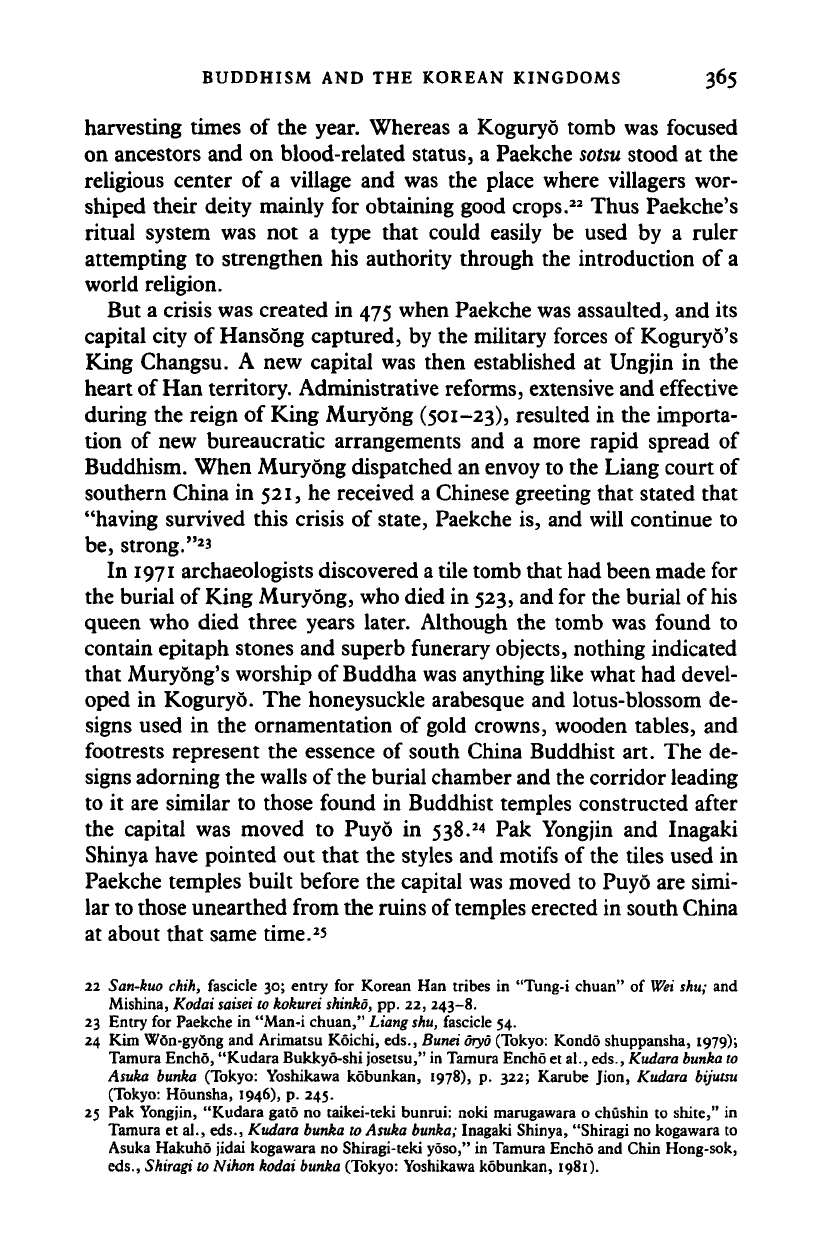
BUDDHISM AND THE KOREAN KINGDOMS 365
harvesting times of the year. Whereas a Koguryo tomb was focused
on ancestors and on blood-related status, a Paekche
sotsu
stood at the
religious center of a village and was the place where villagers wor-
shiped their deity mainly for obtaining good crops.
22
Thus Paekche's
ritual system was not a type that could easily be used by a ruler
attempting to strengthen his authority through the introduction of a
world religion.
But a crisis was created in 475 when Paekche was assaulted, and its
capital city of Hansong captured, by the military forces of Koguryo's
King Changsu. A new capital was then established at Ungjin in the
heart of Han territory. Administrative reforms, extensive and effective
during the reign of King Muryong (501-23), resulted in the importa-
tion of new bureaucratic arrangements and a more rapid spread of
Buddhism. When Muryong dispatched an envoy to the Liang court of
southern China in 521, he received a Chinese greeting that stated that
"having survived this crisis of state, Paekche is, and will continue to
be,
strong."
2
3
In
1971
archaeologists discovered
a
tile tomb that had been made for
the burial of King Muryong, who died in
523,
and for the burial of his
queen who died three years later. Although the tomb was found to
contain epitaph stones and superb funerary objects, nothing indicated
that Muryong's worship of Buddha was anything like what had devel-
oped in Koguryo. The honeysuckle arabesque and lotus-blossom de-
signs used in the ornamentation of gold crowns, wooden tables, and
footrests represent the essence of south China Buddhist art. The de-
signs adorning the walls of the burial chamber and the corridor leading
to it are similar to those found in Buddhist temples constructed after
the capital was moved to Puyo in
538.
24
Pak Yongjin and Inagaki
Shinya have pointed out that the styles and motifs of the tiles used in
Paekche temples built before the capital was moved to Puyo are simi-
lar to those unearthed from the ruins of temples erected in south China
at about that same time.
2
*
22 San-kuo chih, fascicle 30; entry for Korean Han tribes in "Tung-i chuan" of Wei shu; and
Mishina, Kodai
saisei
to kokurei
shinkd,
pp. 22, 243-8.
23 Entry for Paekche in "Man-i chuan," Liang
shu,
fascicle 54.
24 Kim W6n-gy6ng and Arimatsu Koichi, eds., Bunei
oryo
(Tokyo: Rondo shuppansha, 1979);
Tamura Encho, "Kudara Bukkyo-shi josetsu," in Tamura Encho et al., eds., Kudara
bunka
to
Asuka bunka (Tokyo: Yoshikawa kobunkan, 1978), p. 322; Karube Jion, Kudara bijutsu
(Tokyo: Hounsha, 1946), p. 245.
25 Pak Yongjin, "Kudara gato no taikei-teki bunmi: noki marugawara o chushin to shite," in
Tamura et al., eds., Kudara bunka to Asuka bunka; Inagaki Shinya, "Shiragi no kogawara to
Asuka Hakuho jidai kogawara no Shiragi-teki yoso," in Tamura Encho and Chin Hong-sok,
eds.,
Shiragi to Nihon kodai bunka (Tokyo: Yoshikawa kobunkan, 1981).
Cambridge Histories Online © Cambridge University Press, 2008
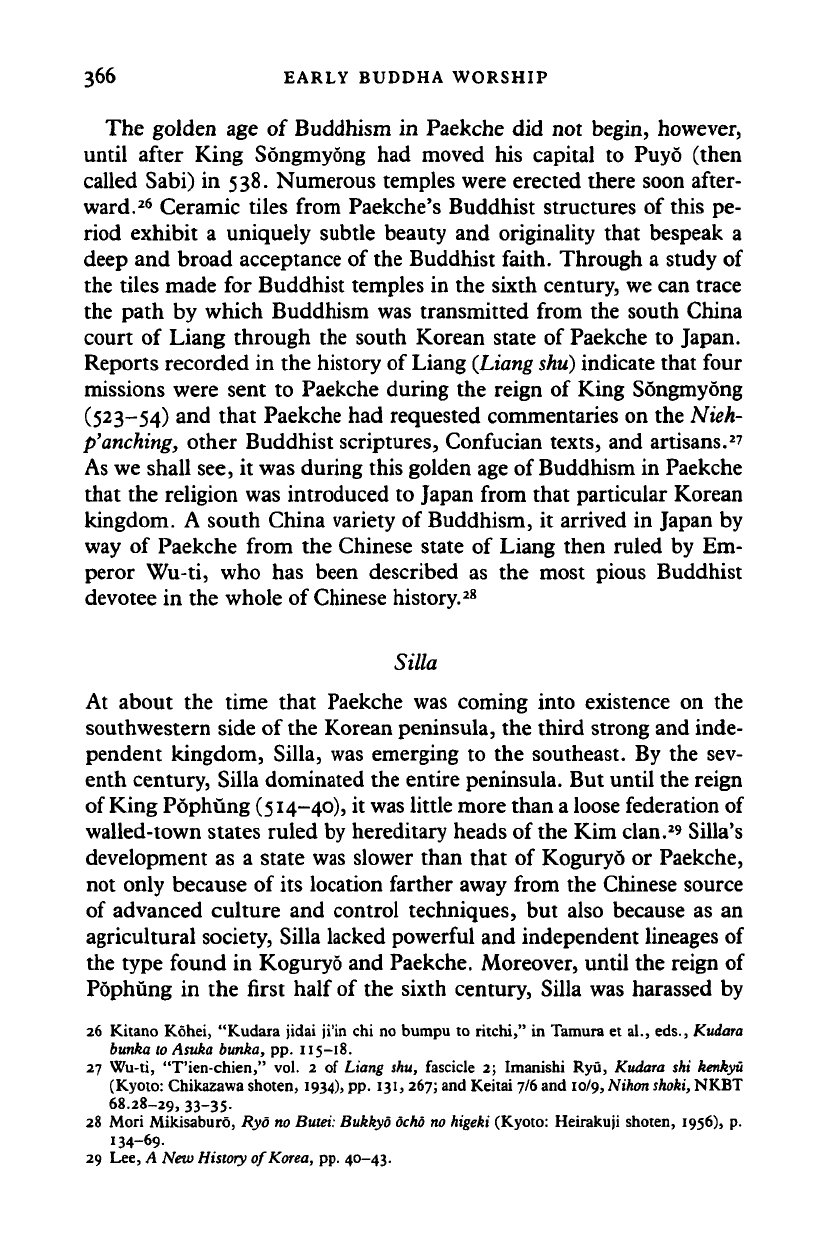
366 EARLY BUDDHA WORSHIP
The golden age of Buddhism in Paekche did not begin, however,
until after King Songmyong had moved his capital to Puyo (then
called Sabi) in 538. Numerous temples were erected there soon after-
ward.
26
Ceramic tiles from Paekche's Buddhist structures of this pe-
riod exhibit a uniquely subtle beauty and originality that bespeak a
deep and broad acceptance of the Buddhist faith. Through a study of
the tiles made for Buddhist temples in the sixth century, we can trace
the path by which Buddhism was transmitted from the south China
court of Liang through the south Korean state of Paekche to Japan.
Reports recorded in the history of Liang
(Liang shu)
indicate that four
missions were sent to Paekche during the reign of King Songmyong
(5
2
3-54) and that Paekche had requested commentaries on the Nieh-
p'anching,
other Buddhist scriptures, Confucian texts, and artisans.
2
'
As we shall see, it was during this golden age of Buddhism in Paekche
that the religion was introduced to Japan from that particular Korean
kingdom. A south China variety of Buddhism, it arrived in Japan by
way of Paekche from the Chinese state of Liang then ruled by Em-
peror Wu-ti, who has been described as the most pious Buddhist
devotee in the whole of Chinese history.
28
Silla
At about the time that Paekche was coming into existence on the
southwestern side of the Korean peninsula, the third strong and inde-
pendent kingdom, Silla, was emerging to the southeast. By the sev-
enth century, Silla dominated the entire peninsula. But until the reign
of King Pophung (514-40), it was little more than a loose federation of
walled-town states ruled by hereditary heads of the Kim clan.
29
Silla's
development as a state was slower than that of Koguryo or Paekche,
not only because of its location farther away from the Chinese source
of advanced culture and control techniques, but also because as an
agricultural society, Silla lacked powerful and independent lineages of
the type found in Koguryo and Paekche. Moreover, until the reign of
Pophung in the first half of the sixth century, Silla was harassed by
26 Kitano Kohei, "Kudara jidai ji'in chi no bumpu to ritchi," in Tamura et al., eds., Kudara
bunka to Asuka bunka, pp. 115-18.
27 Wu-ti, "T'ien-chien," vol. 2 of Liang shu, fascicle 2; Imanishi Ryu, Kudara shi kenkyu
(Kyoto: Chikazawa shoten, 1934), pp. 131, 267; and Keitai 7/6 and 10/9, Nihon
shoki,
NKBT
68.28-29, 33-35-
28 Mori Mikisaburo, Ryo no Butei: Bukkyo
ocho
no higeki (Kyoto: Heirakuji shoten, 1956), p.
134-69.
29 Lee, A New History of Korea, pp. 40-43.
Cambridge Histories Online © Cambridge University Press, 2008
